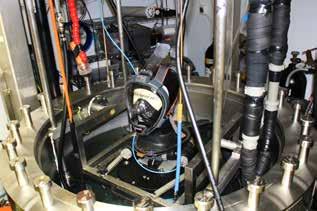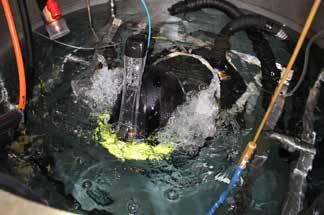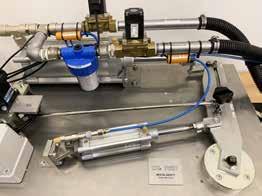
4 minute read
DEVELOPMENT OF THE SAFETY STANDARD BEHIND OUR PRODUCT
The most common concern expressed regarding FFSM use is that CO2 could accumulate inside some brands of FFSMs and result in injury or death.
CO2 (Carbon Dioxide) is a gas naturally present in the air we breathe. • Concentration of CO2 in the air is approximately 0.04%. • Concentration of CO2 in exhaled air (the “waste” of our breathing cycle) is around 4.5%.
Advertisement
An atmosphere containing more than 5% of CO2 is considered toxic.
OCEAN REEF invented the FFSM in 2012. And, since then, more than 1,000,000 masks designed and manufactured by OCEAN REEF have been sold and safely used throughout the world.
Additionally, OCEAN REEF has more than 25 years of design and production experience in the US/EU military, professional and recreational full-face scuba diving mask and gas mask industries. Not only we determined, thanks to our manufacturing experience, what exhisting safety norms could apply to the engineering of our products - we decided to have a third party entity test our products, we traveld abroad to test in other independent labs, we tested competition products as they were introduced to the market, and, last but not least we also had physiology professors give us lessons regarding the way our bodies work and the effective risks of CO2.
We want to share our knowledge related to FFSM safety, specifically related to potential risks concerning CO2.
SAFETY FIRST, AS THE INNOVATOR OF THE MARKET
In a gas mask, there are 2 separated volumes:
Upper volume (RED) and Lower volume – technically called Orinasal Pocket (BLUE) The FFSM shares this same design, which means that the breathing cycle of both products perform in the same manner.
What is DEAD AIR SPACE? 1. Inhaled air goes from outside to inside the mask (from the filter in a gas mask, from the snorkel in a FFSM). 2. Inhaled air is transferred from the upper volume (where it fogs visibility through the mask) to the lower volume, via the one-way valves in the orinasal pocket, reaching the inside of the orinasal pocket. 3. The air is, then, inhaled by the user. 4. Exhaled air cannot move back into the upper volume, because the orinasal pocket seals the nose and mouth around the cheeks. The valves are one-way valves and do not open upwards. 5. The exhaled air moves in the only direction it can: through an exhalation one-way valve (in case of gas masks) and through the exhalation channels, and one-way valves in the snorkel (in case of our FFSM). This breathing cycle is called one-way breathing circulation. The benefit is to separate fresh air, containing only 0.4% CO2, from used, exhaled air with 4% CO2 concentration.
Dead Air Space is the area inside the mask where there is a mixing of fresh air with exhaled air. This volume is limited to the orinasal pocket, in gas masks and our FFSMs. However, if one-way valves are NOT installed at the top of a FFSM’s snorkel, the dead air space would also include the snorkel, along with any other space where separation between exhaled and fresh air is not guaranteed.
However, to be able to sell a product on EU territory, a product must pass the EU NORM STANDARDS for the relevant class of products.
Given the similarity between the 2 classes of products, when searching for applicable safety standards, we naturally thought of Gas Masks, EU regulation: EN 136.
EN136 has a specific guideline regarding CO2 concentration in masks with orinasal pockets. The MAX concentration of CO2 in the volume where the user will breathe must be 1% at a ventilation rate of 50 liters / minute.
OCEAN REEF FFSMs have undergone such tests, conducted by an independent Certification Laboratory. OCEAN REEF masks were tested and maintained an average CO2 level lower than 1%, as per EN136.
OCEAN REEF masks averaged a CO2 concentration of 0.8%, thus exceeding the test standard.
Our test results are publicly available on our website.

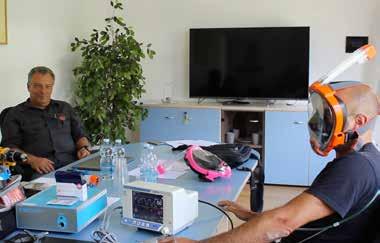
Testing with Physiology professor and medical equipment.
During engineering and production, we applied EU standard EN 1972 – a standard created for conventional snorkels.
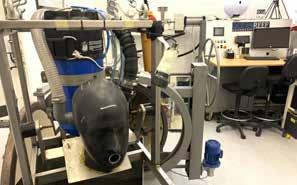
Breathing effort is one aspect considered in this standard. This test is aimed to quantify the effort needed for a normal person to safely breathe (inhaling and exhaling) through a snorkel. EN1972 requires the manufacturer to perform both inhalation and exhalation testing: +/- 10mbar. These tests were also conducted by an Independent European Certification Laboratory. Tests for OCEAN REEF products resulted in an average effort of: 8.53 mbar inhalation and 7.26 mbar exhalation.
Again, both values were well below the standard limit.
